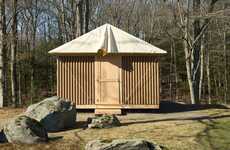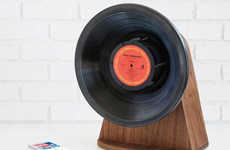
The Cast Iron House by Shigeru Ban Seamlessly Blends Old and New
Mary Van Puymbroeck — August 24, 2017 — Art & Design
References: castironhouse & dezeen
Tribeca's 'Cast Iron House' comes to life with its revived Victorian interiors.
Cast Iron House contains 11 duplex apartments and two penthouse suites. Designed by the Japanese architect, Shigeru Ban, the first images of the highly anticipated restoration have been unveiled. When reconceptualizing Cast Iron House, Ban worked to blend the historically important components of the building with a timeless, minimalistic design. Ban described the revived Victorian building as, "a ship in a bottle."
The interior of the building is light and lofty due to the incredible windows that line its exterior. To contrast the detailed facade of the building and provide some weight to the space, geometric lines are used on the furnishings. A more modern approach adds interest and a timeless nature to the space.
Cast Iron House contains 11 duplex apartments and two penthouse suites. Designed by the Japanese architect, Shigeru Ban, the first images of the highly anticipated restoration have been unveiled. When reconceptualizing Cast Iron House, Ban worked to blend the historically important components of the building with a timeless, minimalistic design. Ban described the revived Victorian building as, "a ship in a bottle."
The interior of the building is light and lofty due to the incredible windows that line its exterior. To contrast the detailed facade of the building and provide some weight to the space, geometric lines are used on the furnishings. A more modern approach adds interest and a timeless nature to the space.
Trend Themes
1. Revived Victorian Interiors - The trend of restoring and embellishing the features of historic buildings with modern interior designs and furniture.
2. Minimalistic Design - The trend of creating simple, uncluttered, and functional spaces using minimal elements and colors to create a timeless look.
3. Geometric Furnishings - The trend of incorporating geometric shapes and patterns on furniture to add interest and contrast to a space with a historical or traditional look.
Industry Implications
1. Real Estate - Developers and real estate agents can leverage the trend of reviving historic properties through modern interior design to attract high-end buyers and tenants.
2. Interior Design - Interior designers can add value to their businesses by mastering the skills required to revive and create minimalist and geometric spaces that complement historic buildings.
3. Furniture Industry - Furniture designers and manufacturers can introduce innovative designs that incorporate geometric shapes and patterns to complement the interior design trend of minimalistic spaces.
1.3
Score
Popularity
Activity
Freshness























